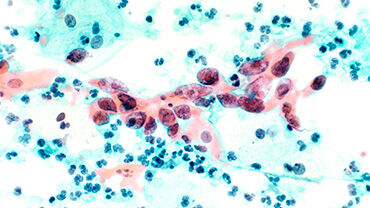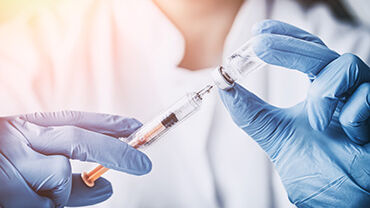Guidance on HPV vaccination in EU countries: focus on boys, people living with HIV and 9-valent HPV vaccine introduction
This guidance on human papilloma virus (HPV) vaccination in EU countries covers the following areas: efficacy/effectiveness of the 9-valent HPV vaccine, efficacy/effectiveness of HPV vaccination in people living with HIV, efficacy/effectiveness of HPV vaccination in males, and the cost-effectiveness of expanding the HPV
vaccination programme to include males.
ECDC previously produced two guidance documents in 2008 and 2012 that addressed questions related to the introduction of HPV immunisation in EU/EEA Member States. This guidance partly complements and updates the information presented in the previous guidance documents. It also covers the efficacy of the 9-valent vaccine,
which was not licensed when the last guidance was published.
The document summarises evidence from studies included in the licensing file of HPV vaccines together with postlicensure, peer-reviewed data and analysis where available. This guidance does not address the safety of HPV vaccines observed during the pre- and post-licensing period.
Executive Summary
Guidance development
A comprehensive review and appraisal of the evidence concerning the areas mentioned above was conducted using the GRADE methodology whenever applicable. Three new systematic reviews were performed and used alongside an already published one, to collect evidence on each topic. An ad hoc expert panel reviewed the appraised body of evidence, provided information on additional evidence and identified evidence gaps for future research. The panel formulated the conclusions listed below based on the evidence provided.
Key conclusions
- The 9-valent HPV vaccine is efficacious in preventing persistent HPV infection and cervical high-grade or worse lesions caused by the additional HPV types 31, 33, 45, 52 and 58 covered by the vaccine (evidence quality: high) and HPV types 6, 11, 16 and 18 (evidence quality: moderate due to indirectness) in females 16–26 years.
The 9-valent HPV vaccine is also efficacious in preventing persistent HPV infections, genital warts and highgrade anal intraepithelial lesions caused by HPV types 6, 11, 16 and 18 (evidence quality: moderate due to indirectness) among males 16–26 years. Immunogenicity data suggest:- non-inferiority of the 9-valent HPV vaccine compared to the quadrivalent HPV vaccine against HPV types 6, 11, 16 and 18;
- stronger immune response against the additional serotypes 31, 33, 45, 52 and 58 contained in the 9- valent HPV vaccine compared to the quadrivalent HPV vaccine;
- stronger immunogenicity of the 9-valent HPV vaccine against vaccine serotypes in males and females 9–15-years compared to females 16–26 years.
- The quadrivalent HPV vaccine reduces the risk of persistent HPV infections, genital warts and high-grade anal intraepithelial lesions in males 16–26 years (including men who have sex with men) (evidence quality: high), while data on the efficacy of the bivalent HPV vaccine against HPV infection and HPV-related disease in males were not found. Immunogenicity data suggest:
- non-inferiority of quadrivalent and bivalent HPV vaccines administered to males compared to females;
- higher immunogenicity of quadrivalent and bivalent HPV vaccines administered to males 9–15 years compared to females aged 16–26 years for specific HPV types contained in each vaccine.
- There was no direct evidence of the efficacy of HPV vaccination on HPV-related clinical outcomes in people living with HIV for the period covered by the systematic review, although low quality evidence of efficacy of the quadrivalent HPV vaccine against HPV persistent infection and against oral HPV infection became available in 2018 and 2019.
- Cost-effectiveness analysis is sensitive to context, and context-specific studies should ideally be done to inform decision-making in this area. According to the cost-effectiveness models reviewed, if the priority is the prevention of cervical disease in women, adding males to current female-only HPV vaccination programmes becomes increasingly cost-effective where there is:
- persistently lower vaccination coverage among females;
- lower vaccine cost
However, increasing vaccination coverage among girls may still be a more cost-effective primary objective.
If the objective of the HPV vaccination programme is to prevent HPV-related disease in general, a universal HPV vaccination may be more cost-effective.
Possible public health implications
Greater benefit and protection from the vaccine is thought to come from immunising preadolescent individuals, since HPV vaccination is more efficacious when given to subjects naïve to the HPV types contained in the vaccine, and the immunogenic response has been observed to be stronger in preadolescents than adults. Subjects at higher risk of HPV infection and illness, including but not limited to people living with HIV and men who have sex with men, may also benefit from the vaccination despite possibly experiencing lower vaccine efficacy due to increased risk of exposure to HPV types included in the vaccines or lower immune response.
As for vaccination programmes, a universal (i.e. gender-neutral) vaccination strategy demands more resources, but will likely provide more resilient herd protection at lower levels of vaccine uptake. It may also lead to a more pronounced decrease of HPV viroprevalence and circulation, and could more effectively protect all risk groups by providing more equitable access to direct protection.
A female-only HPV vaccination of preadolescent girls is probably more cost-effective at current vaccine cost, but does not sufficiently protect men who have sex with men. It is less equitable and less resilient to sudden drops in vaccine uptake.
If vaccination uptake is lower in specific population subgroups (in terms of geographical region, ethnicity, socioeconomic status and religion), it may be advisable to channel resources to increasing uptake among these undervaccinated groups. Different sexual mixing patterns in each population may in fact leave some minority groups excluded from the benefits of the intervention (i.e. when sexual partners are mainly chosen from the same population subgroup). Targeting any such group is an option to consider to ensure equity of access and to improve the effectiveness of the HPV vaccination programme.
Ongoing studies will provide evidence on certain identified research gaps concerning HPV vaccination and allow for additions and updates to this guidance.
Publication data
Data set
Evidence of the efficacy of the HPV vaccines in males
Efficacy/effectiveness, immunogenicity, safety and tolerability of HPV vaccines in males
Data set
Evidence of the immunogenicity of HPV vaccines in males
New evidence on efficacy, immunogenicity and safety of HPV vaccines for boys/men
Data set
Evidence of the safety of the HPV vaccines in males
Efficacy/effectiveness, immunogenicity, safety and tolerability of the HPV vaccines in males
Data set
Evidence of the efficacy of the 9vHPV vaccine
Efficacy/effectiveness, immunogenicity, safety and tolerability of the 9-valent HPV vaccine.
Data set
Evidence of the immunogenicity of the 9vHPV vaccine
Efficacy/effectiveness, immunogenicity, safety and tolerability of the 9-valent HPV vaccine
Data set
Evidence of the safety of the 9vHPV vaccine
Efficacy/effectiveness, immunogenicity, safety and tolerability of the 9-valent HPV vaccine.
Data set
Evidence of the immunogenicity of the HPV vaccine in HIV-infected men and women
Efficacy, immunogenicity, safety and tolerability in other populations not previously targeted by immunisation programmes: HIV-infected
Data set
Evidence of the safety of the HPV vaccine in HIV-infected men and women
Efficacy, immunogenicity, safety and tolerability in other populations not previously targeted by immunisation programmes: HIV-infected men and women








